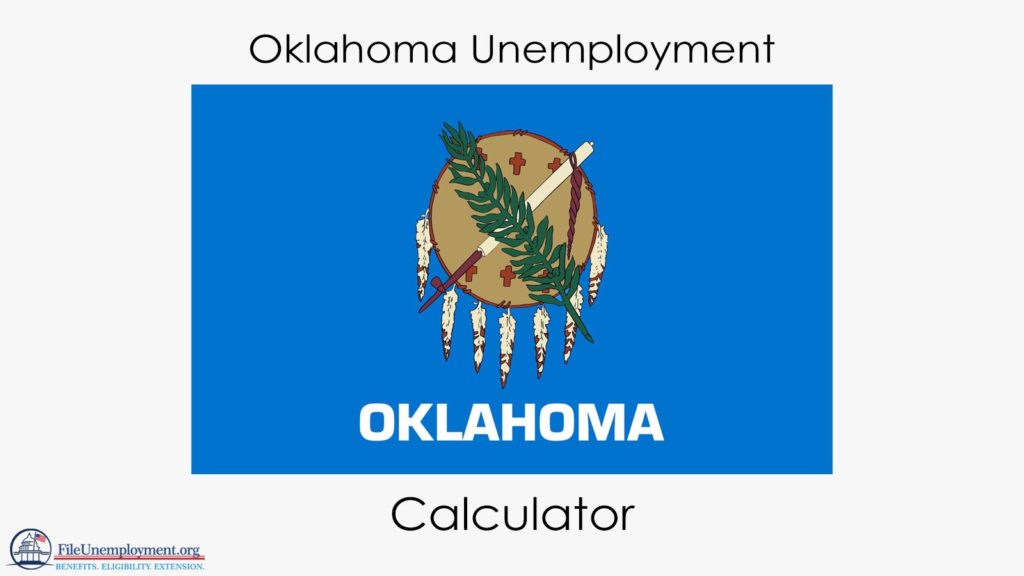
Calculate your estimated Oklahoma unemployment benefit by entering your quarterly wages earned below:
This free calculator tool can help you estimate your Oklahoma unemployment payments. Information is an estimate and not a guarantee of benefits.
Oklahoma Unemployment Benefits Calculator
How are Oklahoma benefits calculated?
In order to calculate your weekly benefit amount (WBA) the Oklahoma Employment Security Commission will look at your base period (more on that later). The OESC will take your highest earning quarter from that base period and multiply it by 1/23 to get your weekly benefit amount, rounding the end result up to the nearest dollar.
The minimum amount for a WBA in Oklahoma is $16, while the maximum amount is $539. In most cases, jobless individuals can collect Oklahoma unemployment benefits for up to 26 weeks. Generally speaking, an Oklahoma unemployment extension is unavailable except in periods of high unemployment.
Once you are filing your weekly unemployment claims, you may also collect wages from part time work totaling less than 32 hours each week. As long as these wages are less than your weekly benefit amount plus $100, you may collect UI benefits that week. For example, if your WBA is $300, but you work part-time and earn $250, you could actually still collect that week.
Unlike other states, Oklahoma does not specify that they will reduce your benefits for any kind of amount based on your part time earnings. However, just like every other state in the United States, residents collecting unemployment must report all earnings, including cash payments.
For example, if your highest quarter in the calendar year as an employee saw you earning $20,000, multiplying that by (1/23) would yield $870. However, since the maximum amount of unemployment compensation you can collect is $539, that would be your WBA for 26 weeks. Your benefits are subject to tax withholding, but you can always choose to pay the taxes later so you can immediately collect the maximum amount you can in order to keep paying your bills.
Estimating your unemployment payment:
Before you file for unemployment insurance benefits, it’s a good idea to use an Oklahoma unemployment calculator to see what your potential maximum weekly benefit may be. This is because once you begin collecting Oklahoma unemployment insurance, it can be difficult to file an appeal with the Oklahoma department to change the amount if you think you are owed more. You should be ready to know how much unemployment compensation you should be paid before your monetary determination letter arrives.
Use this tool to see how much you will get. Simply input your taxable income into each quarter. If you need help calculating your taxable wage base, you can look at something like a W-2 or other payroll information that will list your complete taxable wages per year or per quarter.
Unlike some states, Oklahoma does not offer additional compensation for dependents, so that will not be factored into the calculation. Remember you are reporting gross income, not net income, so that is actually the income on your paycheck before the tax withholding of things like payroll taxes. Also factor in cash payments like tips. If you need to contest this later, you can always use something like a tax return.
Understanding your base period:
In Oklahoma, your base period is the first four complete calendar quarters out of the last five calendar quarters prior to the date you first filed your initial application for unemployment benefits. For example, if you filed your initial application after April 1st, your base period would be the 12 months between January 1st and December 31st of the previous year.
To qualify for Oklahoma unemployment, the total wages earned in your base period must be at least $1,500 and the entirety of these wages must exceed the earnings in your highest grossing calendar quarter by at least 1.5 times. Keep in mind these are just the monetary requirements around your base period, and there are other requirements for collecting UI benefits, such as the nature of how you became unemployed and whether or not you are engaged in a job search while filing for benefits.
Oklahoma unemployment payments:
In Oklahoma, unemployment insurance compensation is issued onto a debit card serviced by Conduent. This unemployment debit card will be mailed to you the day after your first weekly certification for benefits. Generally speaking, it takes 10-14 days to receive the card. If more than 14 days have passed, but you received a monetary determination letter from OESC that you met the requirements for Oklahoma unemployment, you should call Conduent at 866-320-8699 to resolve your missing card issue.
Oklahoma residents who want to receive their UI insurance benefits payments via direct deposit may also select that option, but only after they have received their debit card. This is because the funds will not be transferred directly from OESC, but rather from Conduent. Therefore, once you receive your unemployment debit card, you need to call 866-320-8699 or visit GoProgram.com to input your banking information using the automated system.
Once you stop collecting unemployment benefits, do not throw your card away. This is because if you ever file for unemployment again within the next three years, the benefits will once again be issued to the same card. Direct deposits are deactivated for accounts that have not had them in 6 months (180 days). That means if previously you had set up direct deposits and once again became jobless more than 6 months later (but still within 3 years), the benefits will be paid to the card unless you once again request direct deposit.




